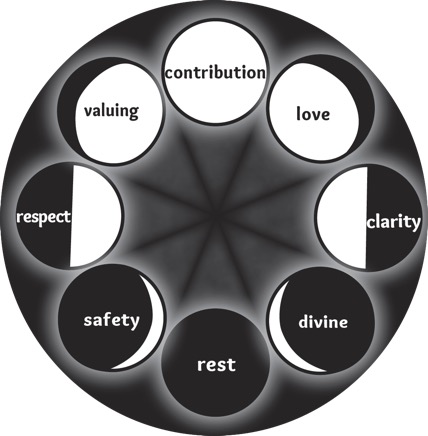7 Keys for Compassionate Communication in Relationships

by Corinna Wood
We’ve all been there. You begin a difficult conversation with the best of intentions. Only to end up at your boiling point, speaking in ways that hurt your loved one—and even surprise yourself.
The next time around, you resolve to keep a lid on your own voice. Lest you end up back in the sea of defensiveness and jabs, blaming and shaming.
But the emotions won’t leave you alone. Inside you struggle with uncertainty, anger or anxiety.
You end up feeling frustrated about communication in relationships. How can you share your feelings in a way that can be heard and understood? How can you show up with respect for both the other person and yourself?
Sometimes it may seem like it’s an impossible task.
But it doesn’t have to be that way.

In this article, we’ll take a look at seven keys to compassionate communication. It all begins with reconnecting with yourself—your own feelings and needs.
With the clarity of understanding your own emotional world, your communication in relationships can support mutual respect and caring. So you can both be heard and understood.
Shall I explain?
7 Keys of Compassionate Communication in Relationships
- Accept and embrace your emotions
- Be curious about your rough feelings
- Acknowledge and express sweet feelings
- Reconnect with your innate underlying needs
- Remember your needs are as natural as the moon and the sun
- Identify met and unmet needs
- Choose wisely where to bare your soul
Relationships are the juice of life—a source of love, connection and passion. Yet we all know relationships can also be fraught with frustration, conflict and heartache.
Early on, I learned firsthand that communication can be either the biggest challenge or the biggest asset in a relationship. So I set out on a lifelong study to better understand how to improve communication in relationships to support harmonious relating. I’ll share with you seven keys that guide the way….
1) Accept and embrace your emotions
 Awareness of your own feelings is the first step for compassionate communication in relationships.
Awareness of your own feelings is the first step for compassionate communication in relationships.
It’s difficult to share yourself with someone else if you don’t allow yourself to feel. And that means all of your emotions—even the difficult ones.
You may have been taught, explicitly or implicitly, to suppress your feelings. Especially the unpleasant ones. Cultural messaging runs strong: Positive vibes only.
Positivity has its place, but when it takes the place of experiencing and expressing difficult emotions, you can end up suppressing aspects of yourself.
Emotions are not like the set of hot and cold faucets that you can turn on or off at will. It doesn’t work that way.
It’s more like putting a kink in the whole hose. When you deny so-called “negative” emotions, your access to your entire range of emotions is reduced—including the “positive” ones.
You may be thinking, “Whoa there, don’t ask me to talk about my feelings.” I get it. It can be scary.
For starters, just focus on asking yourself what you're feeling. And breathe into that. Allow your feelings to naturally arise. No shame, no blame.
Remember, feelings are not evidence of a flaw in your character, nor a sign of weakness. Your emotions are a natural and normal part of being human—and being in relationship with others. This includes the whole range of emotions. From jubilation to frustration. From affection to anger.
Accepting your feelings for what they are—an aspect of yourself—is a surprisingly nourishing step in itself. In turn, that expands your capacity to empathize with the emotions of others—opening the door for authentic communications to flow both ways.
2. Be curious about your rough feelings
 It’s natural to have rough feelings—look at the animal world. Doesn’t your puppy mope around if you’re busy when she wants to connect? Of course, she’s feeling sad or lonely!
It’s natural to have rough feelings—look at the animal world. Doesn’t your puppy mope around if you’re busy when she wants to connect? Of course, she’s feeling sad or lonely!
And when animals are threatened, they show their anger in no uncertain terms—growling through barred teeth, claws poised to strike.
When you connect with your own rough feelings, you can plumb your depths for the truth of who you are and what you long for. It’s natural to feel hurt, sad, or angry at times.
Maybe you’re worried about the loss of a sweet and meaningful connection. Maybe you’re angry because your desire for respect wasn't met in a recent interaction.
Those rough feelings are signaling that something needs to shift. They’re calling you to re-evaluate how you spend your time—and to consider how to nourish yourself so you can be more replenished. These feelings help you initiate healthy changes in your life.
You might get disgruntled in conversations because you’re feeling depleted. It could be that so much of your time and energy has gone to taking care of your loved ones, and your body and heart and calling for you to turn attention to yourself.
Or perhaps you find yourself feeling irritable, agitated, and resentful in your relationships at work. Perhaps you’ve been giving a lot in your job without acknowledgement and recognition, and you want to contribute and express yourself in a more meaningful way.
Your emotions point to what’s underneath. Think of them as guideposts to bring your attention to a deeper, truer part of yourself. Like diving down beneath the surface of the ocean—your feelings help you understand your deepest wishes, dreams, hopes and desires.
Remember, there are no "bad" feelings, only signs pointing to what your heart longs for.
Sharing feelings gained a friendship instead of a fight

My friend Edith overheard her neighbor Kirsten joking at a block party potluck that Edith’s garden looked like a “weed patch.”
At first Edith didn’t say anything, although inside she was stewing.
She and Kirsten had lived in the same neighborhood for years but only saw each other in passing occasionally. How could she say that? She doesn't even know me, Edith thought.
As Edith turned to watch her kids engaged with a scavenger hunt in the summer sun, heat rose in her chest. She looked around for some water. When Kirsten happened over to the drink table as Edith was pouring herself a cold bubbling seltzer water, she decided to speak up.
Edith's first impulse was cut Kirsten down. Edith took a deep breath, tucked away her boxing gloves, and took the risk of sharing her true feelings.
“Hey Kirsten, I heard you joking about my garden being out of control. I feel hurt . . . and actually rather irritable, around that.”
“I’m experimenting with native plants as a community restoration project that I've been really excited about. But right now I'm feeling pretty discouraged."
Kirsten felt touched, surprised by Edith's authenticity. Kirsten leaned into the connection and acknowledged the impact of her comment—and then asked to hear more about the restoration project.
Kirsten's own love for plants and gardening was sparked as Edith tentatively explained, acknowledging her own overwhelm around cultivating the native plant species with so many others competing.
As it turned out, Kirsten offered to help. Edith gratefully accepted.
Having cleared the air, the two women made a date to meet in the garden that weekend. They quickly gained trust in one another. Enjoying the spunk they found in one another, they realized they shared other common interests.
Soon they became best friends. Over the decades, Edith and Kirsten and their families shared many aspects of their lives together.
They often joke about their rocky start—grateful that rather than devolving into a fight, Edith shared her true feelings. Thus they found a long-lasting, treasured friendship.
3. Acknowledge and express sweet feelings
 Give yourself permission to fully experience your sweet feelings as well.
Give yourself permission to fully experience your sweet feelings as well.
As mammals, we're wired for connection. When your pussycat is feeling joyful and loving, she lets you know in no uncertain terms—curling up on your lap purring, rubbing her chin against your hand.
Embracing and savoring sweet feelings is nourishing and healing for yourself and those around you.
You experience sweet feelings like relaxed and joyful when you’re relating eye to eye with another. When you have a sense of connection or community. When you’re seen and appreciated.
Maybe you’ve had a close connection with a girlfriend—leaning on each other through the ups and downs of life? It's natural to long for connections like that.
One of my earliest experiences with that type of connection was as a young women with my dear friend Rowan. I treasured the way I could confide in her—my fears, my insecurities. I no longer felt alone.
She knew what made me tick and encouraged me to follow my dreams and not to give up. And when my creative project, artwork, or idea was accepted, she celebrated my accomplishments with me. As I did with and for her. We left our time together feeling renewed, revived, and grateful for the connection.
How could you cultivate more of those sweet feelings in your relationships today? Be aware of moments—in any of your relationships, be it with partner, family, friends or coworkers—where you sense some those sweet feelings moving through you. Notice when you're feeling relieved. Loving. Hopeful. Open-hearted. Secure. Inspired.
Taking the time to savor and acknowledge those sweet feelings is delicious. While it can be vulnerable, when you give yourself permission to fully experience those tender moments, you open up channels for deeper connection with yourself and others.
Remember, the more you allow yourself to feel, the more you increase your range of tolerance for all your emotions—both the rough ones and the sweet ones. As you turn towards your feelings with kindness and compassion, you tonify your vagus nerve—increasing your resilience to stress and supporting your body's capacity for relaxation, sleep, and internal healing.
4. Reconnect with your innate underlying needs
 Your feelings don’t live in a vacuum. Your feelings are a response to what is going on at a deeper level: your underlying needs. You have rough feelings when your needs are unmet, and sweet feelings when your needs are met.
Your feelings don’t live in a vacuum. Your feelings are a response to what is going on at a deeper level: your underlying needs. You have rough feelings when your needs are unmet, and sweet feelings when your needs are met.
When I share this in classes, my students tend to get a bit fidgety. Some begin to stare off into space, having been shamed for expressing what they needed. Others replay messages heard growing up about how expressing needs is a sign of weakness.
Most women I know are highly tuned towards the needs of others. Yet we often feel hesitant about connecting with our own needs. We learned to repress them.
When you're disconnected from yourself and your needs, it’s hard to be fully present in your relationships.
While denying your needs may be workable in the short term, over time it leads to exhaustion—physically, emotionally and relationally. It disconnects you from your internal compass. Your needs support your thriving.
Developing needs literacy—or needs-based language—for communicating your feelings to others is central to sharing what’s important to you without blame or shame.
The challenge is that it takes some rewiring of the brain. To unlearn the disconnect from your innate needs.
Embracing your own needs and recognizing that all people have needs—no matter how or whether they meet their needs—allows you to develop compassion and empathy for yourself and others.
5. Remember your needs are as natural as the moon and the sun
 At first, I too struggled with the concept of needs. It was hard enough to understand and accept my own needs—never mind to speak about my needs aloud to others.
At first, I too struggled with the concept of needs. It was hard enough to understand and accept my own needs—never mind to speak about my needs aloud to others.
Along my own deep journey of internal healing from early trauma and ongoing relationship stressors, I wondered . . .
What does the nitty-gritty of self love really look like?
What would emotional healing from a needs-based perspective look like?
How can I support herbal actions from the inside out?
As an herbalist and teacher in the Wise Woman Tradition, I turned to the natural world to inform and enrich our understanding of the concepts of needs.
To my delight, I discovered that the cycles of nature reflect the internal pscyhe. You know how each season of nature has a different energy?
For example, during the dark months around winter solstice as the plants are drawing their energy back into their roots, we naturally feel a strong pull towards rest.
I took the long (and in my opinion, rather unwieldy!) list of needs defined by nonviolent communication, and various fields of psychology. And I regrouped them—according to the natural cycles of the seasons and the moons.
 Thus I created the Wise Woman Needs Wheel which became the foundation for my own emotional healing—as well as in the lives of countless students.
Thus I created the Wise Woman Needs Wheel which became the foundation for my own emotional healing—as well as in the lives of countless students.
In short, I've organized the basic needs into eight main categories: rest, safety, respect, valuing, contribution, love & connection, clarity, and divine connection.
Each of those categories contains a group of additional related needs.
You're welcome to grab your own free copy of the full Wise Woman Needs Wheel (pdf).
6. Identify met and unmet needs
 My student Tarah shares how she used to feel bad, but didn’t know why. Without being able to name what wasn’t working, she couldn’t shift to something that worked better for her. She struggled to communicate with others why she was upset, or frustrated.
My student Tarah shares how she used to feel bad, but didn’t know why. Without being able to name what wasn’t working, she couldn’t shift to something that worked better for her. She struggled to communicate with others why she was upset, or frustrated.
Tarah was delighted to discover that through tuning into her needs, she gained a language for things she had been feeling, but didn’t know how to express. Her relationships improved tremendously—as well as her career as an artist.
Your needs provide you with an internal compass. The more you're able to tune into your needs, the more you're able to use them as a guidance system.
In relationships it's natural to long for recognition, appreciation and connection. It is normal to want safety, respect and cooperation. And from that place, we also all organically desire to contribute our gifts to make the world a better place.
These are all natural human needs. Including the needs for contribution, and well-being of another.
If you are feeling exhausted and depleted, that's a signal that your needs aren't being met. It can be difficult or even impossible to give to others from this state.
Giving attention to your own needs, allows you to show up more fully and joyfully in your relationships. As you extend self-empathy and compassion towards yourself, you'll find you’re naturally more compassionate with others.
Working with the Wise Woman Needs Wheel, ask yourself, which needs stand out as being met or unmet? Think of a situation when you recently felt upset or frustrated . . . which needs were not met in that situation? Just being able to identify and name your needs is a surprisingly powerful step in healing emotionally.
Of course, not all of your needs will be met all of the time. Part of the wholeness of light and dark in life is that we have some needs that are met and others that are unmet.
Honoring your needs means not only acknowledging them, but also mourning when they are unmet. Being able to connect your feelings to unmet needs can help you to make choices moving forward.
7. Choose wisely where to bare your soul
 Understanding your emotional world gives you tools and language to improve your communication in relationships. In this way, you can speak and listen with compassion, integrity, and authenticity.
Understanding your emotional world gives you tools and language to improve your communication in relationships. In this way, you can speak and listen with compassion, integrity, and authenticity.
Yet don’t forget to practice healthy discernment about how much to share with others. Remember, being open hearted does not mean you have to bare your soul to everyone!
Early in my studies of nonviolent communication (NVC) , I got excited about expressing myself with this newfound language. Rather than barking, “Go away” in anger, I could say “I feel hurt around my needs for respect.” I liked the way that felt.
When I practiced with my son, it was like magic. His sullen silences subsided and he was more receptive to what I was trying to say.
Then I tried it out on a mean and creepy neighbor. Suffice it to say, it didn’t go so well. He lashed out and made fun of me. Instead of creating more understanding, I exposed myself to more criticism and blame—reinforcing old painful patterns.
Ah, the discernment of where to bare your soul…
Try asking yourself, Do I feel safe with this person? Are my needs for respect and valuing being met? Do I leave this interaction with more clarity about myself? If the answers are no, proceed with caution around how deeply you share—including your needs.
Certainly, sharing your feelings and needs out loud is an invaluable tool for deepening intimacy in relationships in which your sharing is embraced. However, if the relationship lacks safety—and even sharing your authentic feelings and needs is met with criticism—you risk exposing yourself to more hurt and re-wounding.
A helpful way to tune into that discernment is to pay attention to what you're experiencing in your body in the context of relating to others. Be curious and alive to your own awareness and inner wisdom.
What physical sensations do you notice when you're together or when you think about being with that person? Do you feel tension in your belly, or your chest?
Do you feel drained after spending time together?
Scan your body to see what messages it might be sending you.
In this way, you can choose wisely where you bare your soul. This is not about denying, suppressing or silencing your voice.
This is about exploring your emotional world and being very present with yourself and your feelings, and then choosing when to share aloud and when not to share aloud. You’ll be glad you did.
Compassionate communication in relationships
 It’s difficult to communicate your emotions in your relationships when you struggle to name what is going on inside. So my approach to compassionate communication always begins with looking inward.
It’s difficult to communicate your emotions in your relationships when you struggle to name what is going on inside. So my approach to compassionate communication always begins with looking inward.
Your feelings are guideposts to your inner landscape—they’re key to listening to your inner voice.
When emotions begin to bubble up, take some time to hear what they're telling you, and to identify underlying needs that are met or unmet in your life. You'll find a powerful language to comprehend and describe what you're experiencing.
With that clarity of understanding your own emotional world, you can practice healthy discernment about where and with whom to share from that vulnerable and authentic place.
Listen to your body and trust your inner guidance to lead you.
The first step is to give yourself the gift of time and space to hear your inner voice and to listen to what you know inside.
As you develop more empathy towards yourself, you’ll be able to relate more compassionately with others, building trust, understanding and mutual respect.
The road to healthier relationships starts within.
______________
Spread the wise woman ways! Link to this article from your website or share with your friends using this button~
Comments ~ What stands out for you today?








